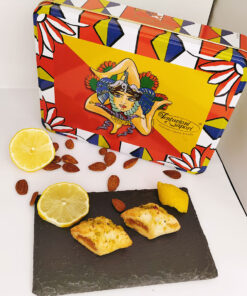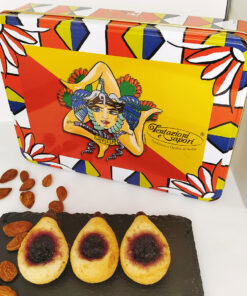
The Cross and The Holy Thorn
When we think of Sicilian traditional pastries several times we think of the fundamental contribution and the culinary art that has been created in its convents, we can define Sicilian pastries as “conventual pastry“, this art flourished in religious structures, with recipes that stand out because of its unique and incomparable characteristics in terms of aromas, flavors and colors.
The Benedictine nuns of the monastery of Santa Croce in Caltanissetta made pastries that resembled the “Holy Thorn” (Spina Santa), and the “Cross” (Crocetta), in deference to the instrument of their martyrdom. These two specialties used to be offered to the notables housed in the structure or given as a gift to thank for the services or favors received.
The Spina Santa was produced annually on the occasion of Holy Week, and the Crocetta di Caltanissetta was produced on the occasion of the feast of the Holy Cross, on 14 September.
This custom was not born for commercial purposes, but for the nuns’ need to reciprocate favors and services received from outside in an elegant and meaningful way. Subsequently, a way was found to maintain it, thanks to the exchange (barter) of raw materials in exchange for the finished product.
In 1908, the nuns had to leave Caltanissetta and their specialties “left” with them.
After the departure, the inhabitants of the town did not know anything about the existence of these pastries. At least three local generations grew up without having the slightest idea that these two confectionery specialties had ever existed.
In recent years, real research on ancient traditional recipes has been carried out and these two particular specialties have come back to light: La Crocetta and La Spina Santa.
The ingredients used in La Crocetta are typical of the Nyssian (Nisseno) area used at the beginning of the last century. Almonds, sugar and sweet lemon, orange or other fruits of the territory were used.

The Crocetta is produced in two variants: lemon with powdered sugar covering it or with orange and crushed pistachio on top.
The ingredients used in the Spine Santa were also typical of the Nyssian area. They used peeled almonds, sweet quince and mulberry puree, sugar and honey, egg white and grated lemon and orange zest, as well as dark chocolate, which was introduced at the beginning of the 19th century in Caltanissetta for the first time.
To enjoy the Spina Santa in all the senses is suggested to eat it starting from the part with the jam and then ending with the taste of the dark chocolate that pampers the palate: subtleties that can make the difference in your “Tasting“.

Both pastries are prepared with the use of high-quality raw materials, strictly organic wheat flour from the Nyssian area (Russello and Timilia or Maiorca). The maiorcone wheat (maiurcuni), is a particular variety of ancient Sicilian white grain soft wheat that was used precisely for the preparation of desserts.
Nowadays, the recipe continues to be a secret: it is known only to four women of faith from the Santa Croce district, who has been entrusted with the task of handing down the tradition, and to the pastry chef who brought it back to light, started by the oral testimony of a local resident, who told of a tradition handed down from mother to daughter of a recipe for an ancient Nisseno dessert.
Now, the choice is yours, if you prefer the Spina Santa or the Crocetta, or maybe both, but in any choice you make, you will always find the magic flavors of the Sicilian ancient recipes.
We suggest combining these delicious pastries with an excellent Sicilian Passito wine dessert and feel a flavor Splash in your mouth!!!

Buy Crocette & Spine Sante
Delicacies
In stock


